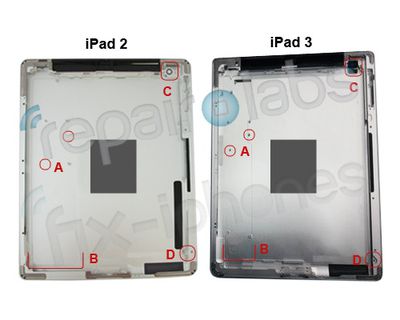TheVerge's Joshua Topolsky summarizes the iPad 3 casing findings reported earlier today, but also adds his own sources regarding some details of the iPad 3.
As expected, the iPad 3 will reportedly include a 2048x1536 Retina Display, be nearly identical physically, and use the A6 processor. The A6 processor, however, is claimed to have a dual-core chip, not a quad-core one, at least according to his sources:
What is surprising, however, is that our sources say that the A6 will not be a quad-core chip, but will remain dual-core. We've previously had heard that the device would have a quad-core CPU as well as an LTE cell radio on-board, but at least part of that story wasn't accurate.
Previous rumors for the iPad 3 have claimed that the A6 processor would include a Quad-Core processor. iOS 5.1 also showed some early evidence of code-support for quad-core processing.
While a dual-core A6 is certainly possible, Topolsky's iOS device sources haven't had the greatest track record. In early 2011, his sources claimed that the iPad 2 would include a "super high resolution display" as well as an SD card slot, and a "completely redesigned" iPhone 5 to come in summer 2011. Topolsky did backtrack on those predictions, but not until the week before the iPad 2's launch.
Topolsky was also the original source of the the tapered iPhone 5 design and elongated home button. While we do believe that design was based in reality, it's hard to ignore that it never came to be.























Top Rated Comments
This is one of the most uninformed posts I have ever read....
On a device with a single-app-at-a-time UI, just how many cores can the OS put to work? Even OSX on the desktop has trouble finding work for a lot of cores to do most of the time (outside of very specialist tasks like video compression).
CPU design will always be a compromise, and it may be that the compromises needed to get to four cores aren't borne out by a worthwhile increase in speed. Are that many cores used on Android, or is it mainly a marketing gimmic?
Think of the CPU as the architect and the GPU as the builders. It takes a lot less time and effort to design than it does to build.
Hyper threading is a trademarked Intel implementation of simultaneous multi-threading. They are the only ones who do it to the point where you have extra cores appearing to the OS. No one else can use intel's patented, trademarked method.
However, multiple issue CPUs with multiple data paths are a staple of modern CPUs and a good thing.
As a user, I want performance and results. I won’t care much how it’s achieved. Double the cores does NOT double performance. There are diminishing returns. Number of cores is one tiny slice of the performance equation. The design of each core, and of the OS, are far more important speed factors. They just don’t sound as nice for bragging to the other kids!
Not that I believe any rumors at this point anyway... but if dual-core means lower battery drain or lower cost, or if the extra cores just don’t add that much real-world performance gain, and if the iPad 3 and iOS are able to deliver great performance from two cores, I will be happy. If I can have all that AND enjoy the sound of the phrase “quad core,” that will be nice too! :)
You are getting bought into the core myth much like the mhz myth of the past.
As others point out the CPU does not play as large of a role in driving the screen as the gpu does.
Sadly the marketers got people believing more cores is better like higher clock rate and that is not always the case.